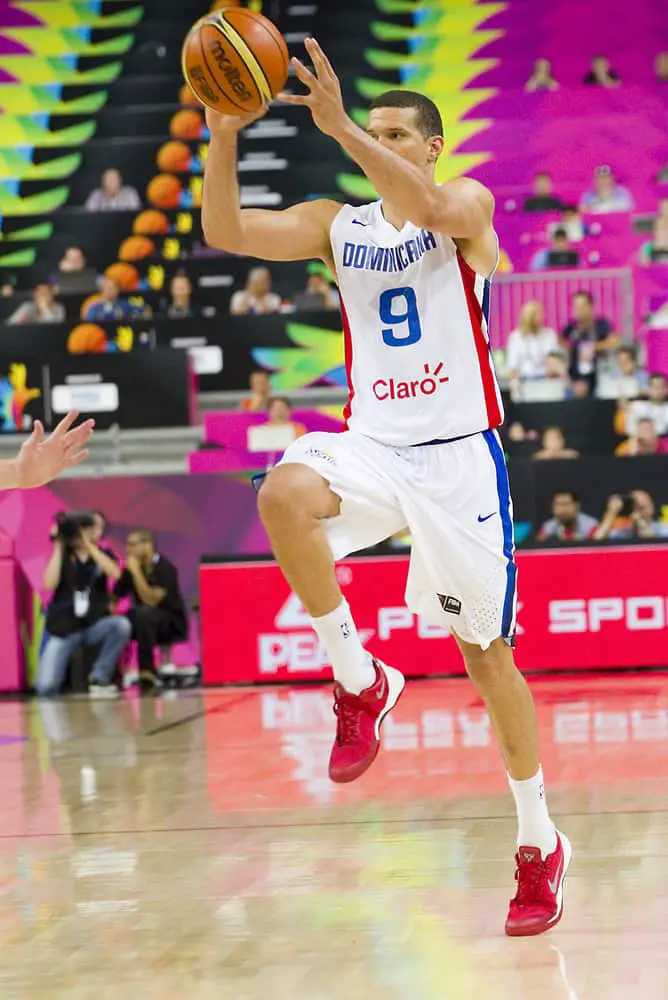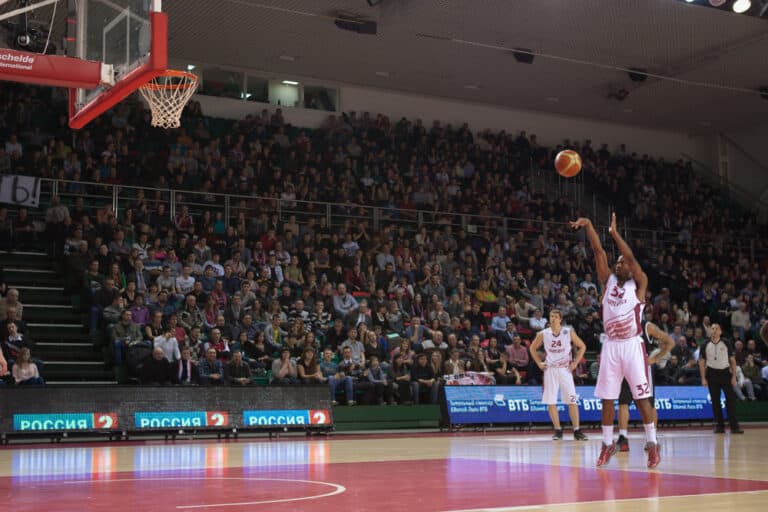How Many Steps Can You Take In Basketball?
Editorial credit: Algimantas Barzdzius / Shutterstock.com
Because basketball is a fast and dynamic sport, it can be challenging to determine the number of steps players take with the ball. So how many steps can a basketball player take before they are penalized for traveling?
Players who do not have the ball in basketball can take as many steps as they want without being penalized. However, a player with control of the ball is allowed a maximum of two steps before dribbling the ball and resetting the step counter.
Although this may seem like a straightforward rule to follow and implement, some definitions allow a level of leniency as to the number of steps a player may take before being penalized, as well as some strict rules regarding traveling and the use of a pivot foot. These will be discussed in greater detail below:
How Many Steps Can You Take Without Dribbling In Basketball?
A player without the ball in basketball, whether on defense or attack, may take as many steps as they want without incurring any penalties or sanctions. However, once a player retrieves the ball and begins an offensive maneuver, they are limited in the number of steps they may take.
The general rule is that a player may take two steps without dribbling, whereafter, they need to initiate a dribble to reset the step counter. Should they fail to reset the step counter by engaging in a dribble, it is a violation, (See below for a discussion on the consequences of traveling.)
In 2018, there was a slight variation to the rule by the FIBA, which allows for a “gather step” once you receive the ball and before taking your two steps, (this is colloquially called the “two-and-a-half step rule by some fans, players, and pundits.)
Further to the above, some other actions may be cited as traveling in basketball:
- Lifting your pivot foot before the ball is released,
- Switching your pivot foot,
- Taking a step standing still and before initiating a dribble,
- Catching your airball,
- Taking two steps after a jump stop,
- Rolling with the ball once losing control of it.
Because there is some confusion regarding traveling and a player lying, falling, or sliding on the floor, the FIBA sought to rectify this confusion with Article 25.22:
- It is legal when a player falls on the floor while holding the ball,
- It is a violation (traveling) if the player rolls or attempts to stand up while holding the ball.
What Is The Penalty For Traveling In Basketball?
Under the NCAA and NFHS rules, a traveling violation means the ball is dead, and a throw-in is awarded to the opposition team out of bounds closest to where the dribbling violation occurred.
The NBA has slightly different rules, whereby the ball is awarded to the opposition team at the nearest spot to the violation but no closer to the baseline than the free throw line extends.
Regardless of the official legislation or format chosen (including most informal basketball games), a traveling penalty means the team with control of the ball must relinquish possession to the opposition team immediately.
Is Traveling Allowed In Different Formats Of Basketball?
Dating back to 1892, “Dr. James Naismith’s 13 Original Rules Of Basketball” suggest that traveling rules were actually much stricter than modern basketball, whereby the number of steps allowed is unclear:
“Rule three: A player may not run with the ball. The player has to throw it from the spot on which he catches it, [with] allowance being made for a man who catches the ball when running at a good speed.”
Following these early rules, rapid changes were made to the traveling rules to make basketball a more dynamic and free-flowing game:
- 1900 – 1901: A dribbler was not allowed to shoot for a field goal and could only dribble once (whereby the dribble had to be performed with two hands.)
- 1908 – 1909: Dribblers were now allowed to shoot. The definition of dribble was redefined to mean “the continuous passage of the ball,” resulting in the double dribble being declared illegal.
- 1921 – 1922: Running with the ball and being cited for traveling was changed from a foul to a violation (creating some leniency and promoting the flow of the game.)
Consequently, while older formats of basketball were stricter on traveling, the evolution of early 20th-century basketball to the modern game saw the emergence of a more dynamic sport that allows for two steps before a violation of “traveling” is cited.
Therefore, save for instances of custom rules during friendly games, some parameters set during practice matches, or the dismissal/leniency of the rule to encourage much younger players to focus on other skills – all formats of national and international basketball recognize dribbling as a violation.

How To Reduce The Risk Of Travelling?
When playing basketball, it feels instinctual to run with the ball toward the hoop without carefully monitoring your steps or foregoing correct dribbling techniques.
There are ways you can improve your dribbling and reduce your risk of being cited for a traveling violation:
- Practice dribbling and make it second nature,
- Never forego dribbling during practice,
- Encourage coaches, referees, and players to cite instances of traveling.
Practice Dribbling And Make It Second Nature
The best way to make dribbling second nature is to practice dribbling at all opportunities. Therefore, even if you are just walking to practice with a basketball, practice dribbling the ball as you walk rather than tucking it under your arm.
Doing so will create a subconscious association between moving with a basketball and dribbling.
Never Forego Dribbling During Practice
Regardless of whether dribbling is the focus of practice, like free throws or defensive maneuverers, you should always dribble the ball at any given moment instead of tucking the ball under your arm.
Encourage People To Cite Instances Of Traveling
Whether you are playing a friendly game of basketball with friends or having a practice match with your team, you should encourage everyone playing and watching to cite traveling instances when they arise.
Conclusion
In conclusion, while not a significant offense or penalty, traveling is a minor violation that can detriment the flow of your game and overall team strategy. Therefore, players should be familiar with the rules of traveling and practice dribbling correctly to counteract them.
References
- https://www.espn.com/blog/truehoop/post/_/id/7097/the-two-step
- https://en.wikipedia.org/wiki/Traveling_(basketball)
- https://www.quora.com/How-many-steps-is-a-travel-is-basketball-James-Harden-takes-3-4-steps-every-shot-How-many-can-I-take-at-the-local-gym-How-many-in-college
- https://www.reddit.com/r/nba/comments/1lyyr3/explanation_of_why_3_steps_is_actually_legal/
- http://fs.ncaa.org/Docs/stats/m_basketball_RB/2017/Rules.pdf







